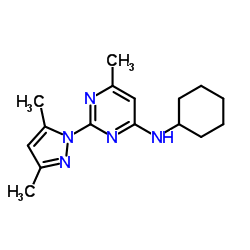CyPPA

CyPPA structure
|
Common Name | CyPPA | ||
|---|---|---|---|---|
| CAS Number | 73029-73-9 | Molecular Weight | 285.387 | |
| Density | 1.2±0.1 g/cm3 | Boiling Point | 512.2±42.0 °C at 760 mmHg | |
| Molecular Formula | C16H23N5 | Melting Point | N/A | |
| MSDS | Chinese USA | Flash Point | 263.6±27.9 °C | |
| Symbol |

GHS07 |
Signal Word | Warning | |
Use of CyPPACyPPA is a positive modulator of hSK3 and hSK2, with EC50 values of 14 μM and 5.6 μM, repectively. CyPPA is inactive on both hSK1 and hIK channels[1][2]. |
| Name | N-cyclohexyl-2-(3,5-dimethylpyrazol-1-yl)-6-methylpyrimidin-4-amine |
|---|---|
| Synonym | More Synonyms |
| Description | CyPPA is a positive modulator of hSK3 and hSK2, with EC50 values of 14 μM and 5.6 μM, repectively. CyPPA is inactive on both hSK1 and hIK channels[1][2]. |
|---|---|
| Related Catalog | |
| In Vitro | CyPPA induces a concentration-dependent increase in the apparent Ca2+-sensitivity of channel activation, changing the EC50 (Ca2+) from 429 nM to 59 nM[1]. |
| In Vivo | CyPPA, a positive modulator of small-conductance Ca2+-activated K+ channels, inhibits phasic uterine contractions and delays preterm birth in mice[2]. |
| References |
| Density | 1.2±0.1 g/cm3 |
|---|---|
| Boiling Point | 512.2±42.0 °C at 760 mmHg |
| Molecular Formula | C16H23N5 |
| Molecular Weight | 285.387 |
| Flash Point | 263.6±27.9 °C |
| Exact Mass | 285.195343 |
| PSA | 55.63000 |
| LogP | 2.13 |
| Vapour Pressure | 0.0±1.3 mmHg at 25°C |
| Index of Refraction | 1.648 |
| Storage condition | 2-8℃ |
| Symbol |

GHS07 |
|---|---|
| Signal Word | Warning |
| Hazard Statements | H315-H319-H335-H413 |
| Precautionary Statements | P261-P305 + P351 + P338 |
| Personal Protective Equipment | dust mask type N95 (US);Eyeshields;Gloves |
| Hazard Codes | Xi: Irritant; |
| Risk Phrases | 36/37/38 |
| Safety Phrases | 26-36/37 |
| RIDADR | NONH for all modes of transport |
| HS Code | 2933990090 |
| HS Code | 2933990090 |
|---|---|
| Summary | 2933990090. heterocyclic compounds with nitrogen hetero-atom(s) only. VAT:17.0%. Tax rebate rate:13.0%. . MFN tariff:6.5%. General tariff:20.0% |
|
Duration differences of corticostriatal responses in striatal projection neurons depend on calcium activated potassium currents.
Front. Syst. Neurosci. 7 , 63, (2013) The firing of striatal projection neurons (SPNs) exhibits afterhyperpolarizing potentials (AHPs) that determine discharge frequency. They are in part generated by Ca(2+)-activated K(+)-currents involv... |
|
|
Identification of the functional binding pocket for compounds targeting small-conductance Ca²⁺-activated potassium channels.
Nat. Commun. 3 , 1021, (2012) Small- and intermediate-conductance Ca(2+)-activated potassium channels, activated by Ca(2+)-bound calmodulin, have an important role in regulating membrane excitability. These channels are also linke... |
| Synthalin sulfate |
| CyPPA |
| N-Cyclohexyl-2-(3,5-dimethyl-1H-pyrazol-1-yl)-6-methyl-4-pyrimidinamine |
| 4-Pyrimidinamine, N-cyclohexyl-2-(3,5-dimethyl-1H-pyrazol-1-yl)-6-methyl- |
| N-cyclohexyl-2-(3,5-dimethyl-1H-pyrazol-1-yl)-6-methylpyrimidin-4-amine |